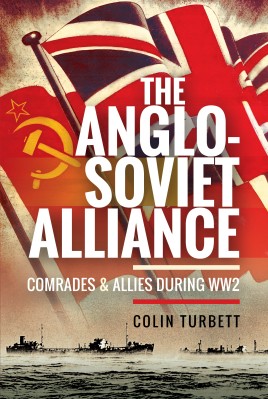Reviewed by1
CDR Jeffrey Holdsworth U.S. Navy
Assistant Professor, JFSC

Foreign policy and national security professionals benefit from timely reminders that reveal the intricacy of personal and organizational relationships, and they are particularly valuable as both a reference point and a measurement during periods of competition. Competition occurs within the context of relationships, and careful examination of how those relationships form and exert influence at all levels of society is valuable to serious, strategic competitors. Colin Turbett is a career British social worker and Soviet historian. In his third published book, The Anglo-Soviet Alliance: Comrades & Allies During WW2, he offers readers an exploration of relationships in the setting of ideological competition before, during, and following conflict. His detailed vignettes provided perspective on the layers that comprise complex, often competitive, relationships.
The book presents a successful and balanced examination of the relationships influencing the British and the Soviets during the Second World War. He focuses on the perspectives of ordinary citizens and selected prominent figures within contemporary British society, and his research reveals details that convey a rich, contextualized experience. Examination of the motivations for friendship, commitments, and alliance between the British and the Soviets emphasizes the sympathies between two populations with starkly different perspectives. By illuminating the tensions operating within British society, he draws a deft line between parallel forces in political and societal circles and shows how and where the circles overlapped in meaningful ways. At the core of the tensions are a pair of competing ideologies held fast by the context of a shared vital interest.
The book thoroughly covers several significant factors that constituted the relationship between the Soviet Union and the British, providing important contextual details that influenced the years following the First World War and the sweeping changes affecting the two societies. On the canvas of that important context, he develops an appreciation for both the sympathies and the tensions between the nascent communist and the established parliamentary systems before exploring the alliance itself. In the subsequent chapters, he continues to highlight significant aspects of the alliance, such as unity of action and cooperation in military relationships and the Arctic convoys. True to the connections between the front lines and the societies, he also opens a window into how the British populace engaged with the concepts of socialism and fascism, both at home and on the front lines in various theaters of war during the conflict. Finally, he examines the fundamental sources of the Cold War that followed from the intimate alliance.
Turbett’s adept and patient examination of the relationship between two militaries, two bodiespolitic, and two societies gives a deep appreciation for the factors that contribute to the inherent complexity of such an alliance. American national security professionals recognize the vital importance of alliances and partnerships in the pursuit of both U.S. interests and ally and partner interests. A casual reader may at first feel distracted by his consistent inclusion of references to other sections and chapters within his book as he carefully constructs the rich context surrounding the alliance. The complexity and nuance of the subject is well-framed through his organization and his skillful employment of the technique. He succeeds in crafting a cohesive whole out of a web of linkages and connections. In the end, it offers the reader welcome ease when choosing a path to follow the details provided in other sections, guided by the curiosity he inspires. His inclusion of selected quotations from leaders and recognized experts further frames the prevailing conditions and factors.
While some of the detailed accounts of key activists within the social and political movements in Great Britain may be more suited to historians of the period, they illuminate crucial factors for today’s national security professionals. The factors take an even sharper point considering the significant technological advances that have accompanied globalization and have forged deeper and perhaps more personal but certainly more instant connectivity between people of disparate ideologies across the globe. For all of the highlights described above, and particularly his illumination of the complex relationships between the two cooperating and competing parties, the addition of Turbett’s book to a shelf is likely to satisfy most professionals in the joint national security community because it satisfyingly grounds strategic thinking in the implicit context. Turbett’s attention to context, too often dismissed as obvious in high-minded abstract discussions, is crucial to understanding the complexities of competition amidst cooperation.2
Book Information:
The Anglo-Soviet Alliance: Comrades & Allies During WW2
by Colin Turbett
Pen and Sword Books Ltd., 2021. 232 pp.
1 The views expressed are those of the author(s) and do not reflect the official policy or position of Joint Forces Staff College, National Defense University, the Department of Defense, or the U.S. Government.
2 A version of this book review previously appeared in the Naval Historical Foundation. It is reprinted here with permission, https://www.navyhistory.org/2021/11/the-anglo-soviet-alliance-comrades-allies-during-ww2/.
 Download the PDF version: click here
Download the PDF version: click here